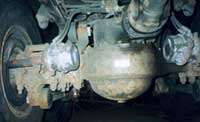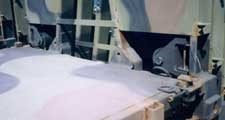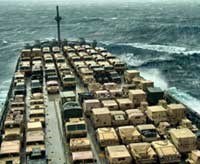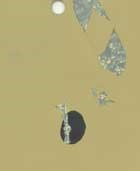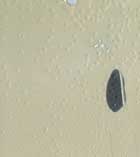Optimizing Paint Durability, Part I
The rapid deployment of military force dictates that military assets be readily available in potential areas of conflict. As a means to this end, military equipment is prepositioned on ships. While the combat systems are sequestered in environmentally controlled holding areas, tactical systems are chained to the deck in a harsh marine environment. Following 24–30 months of marine exposure, the vast majority of once new equipment is in need of selective overhaul…
#military #marine
The Army paint finish with its epoxy primer and polyurethane topcoat should—by design—provide a good finish. An analysis of the returned equipment, however, indicates some serious performance anomalies. These results coupled with isolated paint blistering on new military vehicles and process control failures, indicate that there were factors not presently addressed in the controlling specifications. As laboratory testing of a product does not always represent production variability, a more direct approach was taken for this failure analysis. A comprehensive review of the painting practices at six paint applicators was made to determine the root causes of the deterioration. Products and practices were identified which created these problems. Options are provided to correct the problems. This report reflects the tremendous impact the paint applicator often has in determining the life and continued function of ferrous military equipment.
What We Found
As the equipment was new the impact of gravel impingement or casual paint damage associated with use was minimized. The environmental demands were real salt spray, humidity, thermal cycling and UV resistance. Although the topside surfaces were subject to extreme exposure conditions, the underbody components were more severely corroded than the topside (Anomaly #1). The corners, pockets and inside surfaces of channels and tubes were generally corroded on ferrous surfaces. Although some underbody components were severely corroded, some adjoining components looked relatively good (Anomaly #2).
Featured Content
The same design flaw was prevalent on almost all equipment. To save weight and reduce cost, designers are specifying intermittent welds. The skipped areas should have been filled with an inexpensive caulk or an electrocoat primer could have been specified, which has the highest probability of coating the relatively tight faying surfaces in the unwelded segments. These steel edges are impossible to coat with a sprayed application; there is rust bleed through within two weeks of fielding.
Analytical tools at the overhaul facility were limited to paint film thickness and Tooke gages. Although they may appear insufficient for a failure analysis, they provide objective evidence as to the thickness and type of coatings applied to the surface. Due to the obvious color difference between epoxy-urethane, electrocoat primers and the white/off-white sprayed epoxy primers, primer identification was easy. All the surfaces evaluated had sprayed epoxy finishes. The actual primer thicknesses ranged from 0.6–2 mils. There was a significant difference in the thickness of the polyurethane topcoat on the topside versus the underbody components. The topside surfaces had typically 3.5–7 mils of topcoat while the underbody components had 1.5–2.5 mils. The underbody components that showed minimal deterioration had essentially the same paint film thickness as adjacent rusty parts (3–4 mils total dft).
Just-in-Time… Gone Awry
Electrocoat primers, baking enamels and powder coat systems are ideally suited to quick turnaround. Solvent-borne coatings developed for ambient cure are not…or so we thought. Three interrelated practices were responsible for promoting rapid corrosion of the substrate. Specifically, they are high temperature forced curing, inadequate corner coverage and wet-on-wet painting. Due to a general lack of knowledge in coating chemistry, mechanics and the epoxy-urethane interaction, applicators are unknowingly perforating the paint film.
Forced Curing. Forced curing is necessary to be cost effective in today’s market. It is practiced by 95%+ of the Army’s contractors. The impact of higher throughput on the bottom line is obvious. What is less obvious is the direct impact that environmental initiatives (low VOC primers) have had on the painting process and coating quality. Manufacturing conveyor lines are designed with certain products in mind. Although some flexibility can be introduced with line speed manipulation, quantum changes are difficult without a major overhaul and increase in the manufacturing space claim for the painting process. The original (high VOC) version of the epoxy primer used by the Army was designed with a maximum tack-free time of 15 minutes, which was conducive to high-production rates. In many cases, the primer was tack free in 10 minutes; primed surfaces had a uniform continuous film that easily met performance requirements. Most production lines were apparently designed with this product in mind.
With the low VOC reformulations of the epoxy primer, the tack-free time was doubled to 30 minutes. The tack-free time has major implications when forced curing (oven curing) is involved. The original primer formulation with the quick flash off allowed the primer to enter the oven tack free; now the primer is wet as it enters the oven. When a wet paint film enters a hot, non-zoned oven over 200°F, solvent washing and solvent popping often occur. There is random thinning of the paint film preferentially on vertical surfaces and voids in the epoxy down to the substrate. When some epoxy primers are applied less than 1.0 mil, holidays start to appear. The type and quantity of reducing solvent added to the primer can also contribute to these defects as the tack free time can be greatly increased. Many applicators found that their conveyor length was insufficient to fully cure the paint finish with the slower, more environmentally friendly solvents. The easiest way to compensate for a “short oven” was to increase the temperature. Curing temperatures up to 375°F have been witnessed even though many paint manufacturers recommend a maximum temperature of 180°F. The most efficient way of counteracting these effects is to increase the primer wet film thickness by 50%, i.e. 1.5 mils minimum in the dry film.
Corner Coverage. Part size and geometry dictate the fan size of the spray pattern. Tight corners and accessibility problems are always an issue for the paint applicator. While the best approach would be to have two paint spray guns available to the painter (one with a narrow fan to stripe the corners and edges and the other with a wide fan for maximum efficiency), this is the exception rather than the rule. When a large spray pattern is used and the painter attempts to get complete coverage in tight corners, high-film builds tend to be created on the adjacent areas due to multiple spray passes. This would be an acceptable approach, if wet-on-wet painting and high-temperature force curing were not practiced.
To demonstrate the impact of this technique, test samples were made on the production line to duplicate actual production sequencing. After a relatively high build of epoxy primer, the wet panels were overcoated with 2K urethane five minutes after the primer application (wet-on-wet). Six minutes later, the panels were run through the curing oven at 320°F. In comparison, a second set of test panels was primed with the same technique but allowed to flash off for 25 minutes (tack free) prior to urethane topcoat application. After a six-minute flash off the panels were run through the same curing oven. The test panels that were allowed to flash off for 25 minutes prior to topcoating had a good visual appearance and good adhesion (cross-hatch/tape test). The wet-on-wet sample displayed mixed results (see Figure 1). While one area had good adhesion, two inches away there was almost no adhesion. The top corner displayed a large crack in the paint from extensive solvent popping. A section of the paint finish had delaminated from the zinc phosphate pretreatment. These results reinforce the painting techniques noted at some facilities…the corners tend to receive minimal primer coverage. High builds tend to create obvious paint defects, which must be repaired, affecting delivery schedule and cost. The impact of this painting practice is readily apparent on the returned equipment where extensive corrosion in the corners is evident.
| Wet-onWet (1.2-1.5 mils) |
| SW 53022-75°@6 min |
| Reduces 17%@6 min |
| SW 46168 (17% Acetone) (2.7-3.2) |
| 7 min AT 75°F, 15 min@ 320°F |
| 3mm Solvent Blisters |
| Figure 2. Paint blistering—impact of solvent reduction, wet-on-wet and forced curing. |
Many applicators familiar with commercial urethane primers were under the impression that good coverage with the urethane topcoat in the corners would adequately compensate for thin primer coverage in the corners. That belief is incorrect.
Wet-On-Wet Painting. When this practice is coupled with forced curing, gross defects as noted in Figure 1 can occur or can result in blistering as depicted in Figure 2. This photo depicts a common approach in the solvent-borne paint industry to keep film builds to a minimum—solvent additions. Common solvents are methyl amyl ketone (MAK), methyl isobutyl ketone (MIBK) and acetone for the epoxy primer up to 20% by volume. The film thicknesses are typical for production. This blistering has been noted on random surfaces of new vehicles. Some manufacturers believe that they have unlimited rights to manipulate the application process provided they pass a film thickness and adhesion test.
Although Figures 1 and 2 display paint defects at the macroscopic level, the impact at the microscopic level with wet-on-wet epoxy-urethane painting practices is catastrophic. The solvent package used in the epoxy is chemically incompatible with the urethane. Wet-on-wet practices bring the epoxy solvent package to the unreacted urethane. Technically, both the 2K and 1K urethane topcoats demand water-free solvents (less than 0.2% by weight) with the 1K resin even more sensitive to water contamination than the 2K urethane. The epoxy primers typically contain both an ether alcohol (butanol) and an ester alcohol (propylene glycol methyl ether). Both of these alcohols can contain unacceptable levels of water unless reagent grade alcohols (0.1% water maximum) are used by the paint formulator. (The product specification does not control the contamination level of the solvents.) Water is a serious contaminant to urethane/urea curing reactions as it reacts with the isocyanate in the urethane. Through a series of intermediate reactions carbon dioxide is emitted leaving micropores in the urethane film. It can also inhibit cross-linking. Even if reagent grade alcohols are used, PM glycol ether is hydrophilic and a hydroxyl donor. The hydroxyls react with the isocyanates in the urethane significantly degrading cross-link density i.e., chemical agent resistance has now been seriously compromised.1 Furthermore, with the paint applicator using aftermarket solvents to reduce the paint viscosity, there is a high probability that the solvent could have unacceptable levels of water. Only “urethane grade” solvents should be used. There is no cure for wet-on-wet painting. Don’t do it!
Next Month: Part II of this article discusses production methodologies for improvement of paint durability with an emphasis on pretreatment and topcoat.
Questions regarding the technical content of this article can be directed to the author at shawg@tacom.army.mil.
The author would like to acknowledge the technical support and testing services provided by Richard Perry (retired), Curt Morehead and Joseph Menke at Rock Island Arsenal and TACOM-ARDEC, respectively, on this multi-year project.
RELATED CONTENT
-
America’s Cup Partners With AkzoNobel’s Awlgrip Brand
Awlgrip will be the official coatings supplier for New York Yacht Club’s American Magic team, which will challenge for the 36th America’s Cup.
-
Smooth Sailing for Liquid Finisher
With new technology, a boat yard improves production efficiency and enhances finish quality.
-
A Conversation with Clay Spencer, Simmons Plating and Grinding
L. Clay Spencer IV always planned to join his family’s business, Simmons Plating and Grinding in New Orleans, but after graduating from Tulane with an engineering degree, he served in Iraq as a Marine Corps officer before joining Simmons in 2010.


